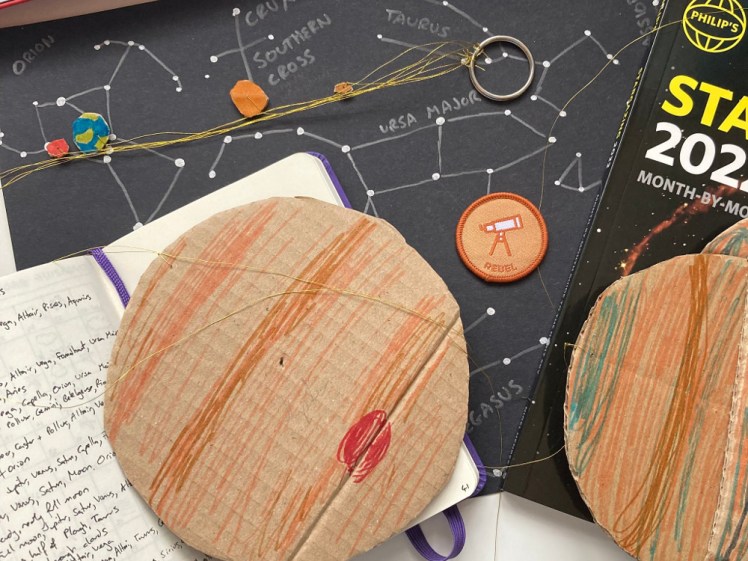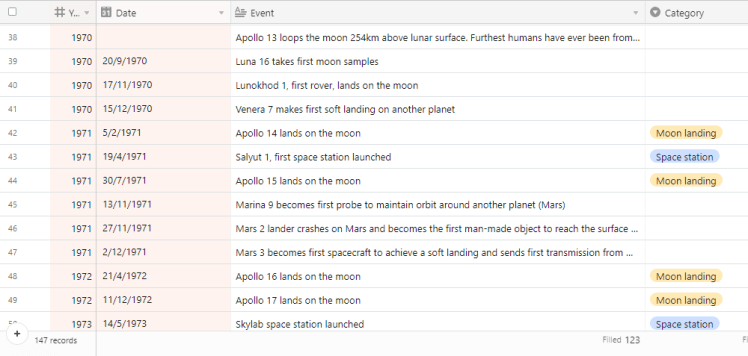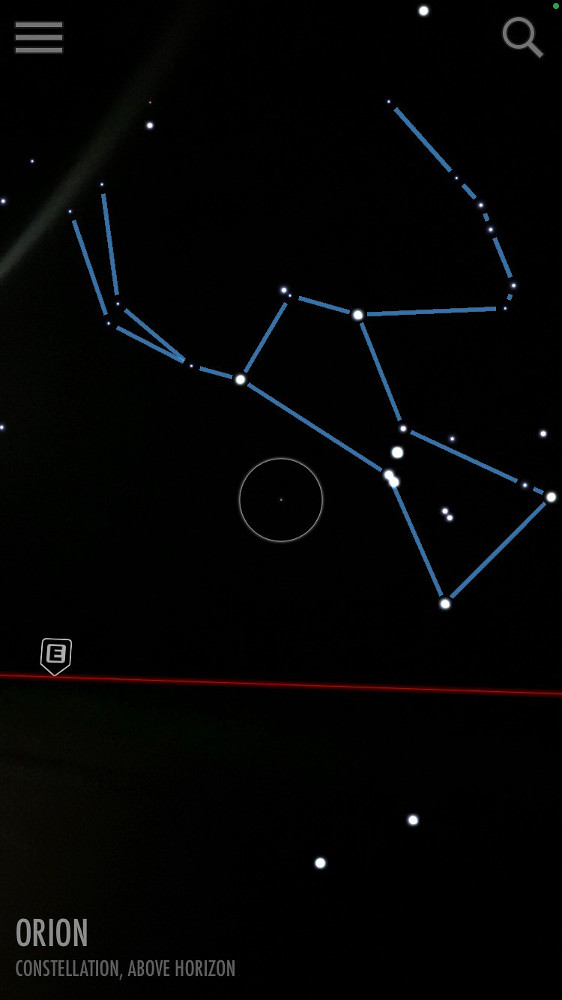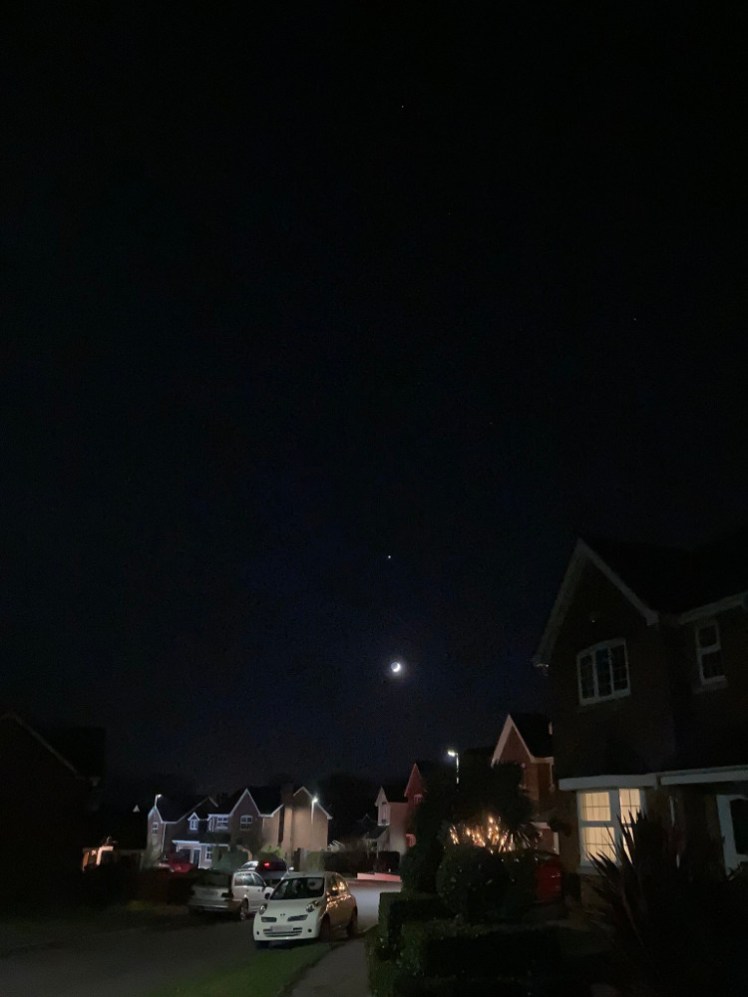Guess what? I did my Rebel Stargazer badge!
I’m not going to do a separate post for every Rebel badge I do – I’ve already talked about the Water Sports badge but Adventurer just got a mention at the bottom of that post, Community Service isn’t getting a post because it’s just doing Brownies and Writer, Self Care & Linguist aren’t going to get posts, although you’ll hear about part of my language journey in April. You’ll hear about Camper because I’m threading it into my June watersports/camping weekend so it’ll get a mention. I don’t know what else I plan to do in the future and which ones will be worthy of their own posts.
But Stargazer is getting a post because stargazing is a new aspect of the outdoors for me.

I never planned to do my Stargazer badge. When I was looking at the nine Wild badges in October, deciding which five to do to get my Wild patch/collective emblem, Stargazer wasn’t among them. Then in early November, I spied Jupiter looming over the house and before I knew it, I was pointing my stargazing app at the sky every night and the Stargazer badge had begun itself. So I decided since it was happening spontaneously, I might as well work my way through the rest of the clauses. There’s nothing else particularly difficult, just more of an exploration of space than I would have ever thought to do on my own – one of the other seven I’d already done, one I was going to do anyway and a couple more were no problem. My timeline of space exploration outgrew the spreadsheet I started it in and is currently a 123-item 11-category mini-database. While Omicron is raging, I opted to order a star projector, which I figured was every bit as good as going to a planetarium and I can switch it on whenever I want, so that was a bit of a cheat but I’ve been to inflatable planetariums and I spent far more time staring at my office ceiling than I would if I’d been to an organised one, so I think I actually did that clause better than if I’d done it properly.



But the big one is the stargazing. “Observe the sky at least twice a week for two months and keep a logbook of what you see”.
Finding a guide to the stars is quite difficult: printed ones in books are too small and too crowded; they only show the big hitters and translating a 3D sky onto a 2D piece of paper means it’s hard to match what you’re seeing on the page to what you’re seeing above your head. I was lucky, I happened to already have a stargazing app and that first evening when Jupiter brought itself to my attention, it happened to have not un-downloaded itself, otherwise I might have lost interest in the stars before I’d even started.

Mine is called SkyView Lite (Apple | Android). I could pay for it to get even more stars and even more constellations but I find the free version is quite enough. The only constellation I want it to see which it won’t is Cassiopeia, which is one I already knew, and there are quite enough stars for me to be kept busy pretty much forever. It also spots the planets, the moon and it showed me the ISS early on in my stargazing adventure. You point your phone’s camera at an unidentified star and it overlays the stars onto the picture and shows you what you’re looking at, filling in the constellations with pretty pictures to help you visualise them.
By now, it’s getting too light when I normally go out straight after work at 5pm to see much. Even Jupiter can be hard to spot these days so I’m putting it off until later in the evening. Who’d have thought that as spring starts to loom on the horizon that I’d deliberately be keeping my daily walks in the dark? I’ve walked every single day since May 1st 2020, so as of today that’s 647 days unbroken. A lot of them are in the dark in winter anyway because it’s easier than fiddling with my work hours.

One thing I’ve learned about as a sort of tangent to stargazing is the Bortle scale. I live in a Bortle 4 zone. The Bortle scale is a measure of sky brightness, with the higher the number meaning the worse the light pollution. A 9 is classified as “inner-city sky” where the only objects you can see are the moon, the planets and a few of the brightest star clusters, where most constellations are invisible and the sky is “brilliantly lit”. A 1 is an “excellent dark-sky site” where there’s no light pollution at all, there are so many stars visible that they crowd out the constellations and Venus and Jupiter can white-out your night vision.
My zone 4 is “rural/suburban transition”. Apparently the Milky Way, which I’ve never seen, should be impressive but lack detail and the zodiacal light is still visible but my surroundings are also clearly visible. The streetlights switch off between about midnight at 5.30am, depending on what the clocks are up to, so I think surely in the darkest parts of night we must be up to at least a Bortle 3, “rural sky” if I could be bothered to trek to the top of the road in the real dark.

I tend to turn left out of the house, towards Jupiter, with Altair and Vega to my right. By the end of the long road, I can see Saturn and Venus ahead – well, I could in November and December. They’re likely to be either too low for me to see or below the horizon entirely by now. I can also spot a few old friends – from a spot near the garages, I can see Diphda and Fomalhaut. Then I walk up to the main road where I start to see the Plough and Taurus to my right.
My last major stop is at the top of my own road, in a position where the streetlights don’t quite white out my stargazing vision. It’s not an ideal spot but if I had to travel to somewhere better, I’d never go. From here, the Plough is on my left and I can now find Polaris just from glancing at the Plough rather than carefully following the Pointers for the correct distance. Vega and Altair are behind me and a few weeks back I had another good view of the planets from up here. Right of the Plough are Castor & Pollux, which means Gemini. Then Orion and above him, Taurus with Aldebaran as the eye, plus a few more stars that are either twinkling away on their own or whose constellations I’ve just never learned – Capella, Alcyon, Deneb, Mirfak & Procyon. Then as I carry on down the road, the houses drop away and if I’m out late enough, I might spy Sirius off to Orion’s left foot and Jupiter opposite, across the dog field. Finally, Fomalhaut (I catch myself saying stupid things like “Hey Foms!” and “Hi Jupez!” and “Ah, of course it’s Capella!” out loud) leads me down the road and there’s Jupiter hovering over my house.
In a way, I’m not doing my star lore much good by doing the same loop and seeing the same stars in the same place every day – or every non-cloudy day, anyway – but on the other hand, I’m getting accustomed to certain patterns and to how the pattern changes. In some cases, I have no idea whether they move and change because I’m going out two hours later than usual or if they move because it’s been cloudy for three weeks and this is just an effect of our orbit and time on our surroundings. Or am I going to find that I’m seeing much the same thing in July that I’ve been seeing in December? Well, as it isn’t going to be dark enough to see the stars until gone 10pm in July, they’ll probably be somewhere different anyway. I know Orion definitely moves between 5pm and 8pm so I imagine that regardless of what the orbit does, it’ll all look different in mid-summer.

However, once or twice I have been out in the evening and seen my stars from a different perspective. The other night I drove home following a star low and bright on the horizon that I just couldn’t identify which turned out to be Vega, the one I’m used to seeing right up high over the neighbours’ houses. Last night I stood next to an airfield and stared at something twinkling blue which I’m reasonably sure was Sirius and not an aircraft. Yes, I’ve just googled it and Sirius is indeed a blue-white star.
Over the last two years, I’ve been learning more about the outdoors and more about my little world. I’m still not great on trees but I know more than I used to, I can identify a lot of the neighbourhood cats and I can tell you exactly which fences have been replaced in the last year. I’ve taken an interest in gardening and in the allotments, I’ve walked around my own hometown and discovered all sorts, including the little urban woodland, I’m (very slowly) working my way around a local OS map. But in all that time, I’ve barely glanced at what’s going on above my head.
From an interstellar perspective, there’s so much more going on up there than there is on this little planet. From an earthly perspective, all you can really do is look at the stars that are visible to your naked eye. No, I’m not going to invest in a telescope. Nope. I had a quick Google to remind myself how much they cost – and that was no help at all because the beginner ones were a lot more affordable than I’d ever imagined. No, I’m not getting a telescope. By the time this is published, I absolutely will not have bought one. I almost certainly will. Just a portable one I can take glamping and camping. Nothing shiny. No telescope at all. I want to buy a house before I’m fifty.
One other outdoors thing I’ve spotted during all this: I knew it academically but somehow I’d never felt it before. I knew it’s colder on clear nights because the clouds act as a blanket and keep the planet warmer but I’m now acutely aware of it. It can go from “no, it’s not really cold at all out there tonight, I carried my coat most of the way” to “I wish I’d added another layer and taken my gloves!” in under 24 hours.

If your interest in the world is exclusively earthbound, do go out in the dark sometime in the next week, even if it’s only in your garden, and look upwards. Apart from anything else, it can’t be a bad thing to learn how to find Polaris and therefore to be able to navigate, however approximately, by night. A mere week after I started taking an interest in the stars, Pointless’s jackpot round was “astronomical objects” and one of the subjects was “the 50 brightest stars in the sky”. One week into this stargazing thing, I definitely got one pointless answer and probably three, since Richard didn’t read out every single one and mine (Fomalhaut, Capella, Altair) weren’t in the high scores he did read out.
So thanks, Rebel Badge Book! You’ve helped me take something from a casual “oh, that’s fun!” to a new hobby and may have even separated me from £110 for a piece of specialist equipment by now. Oh yeah, I was the first Stargazer badge to be sent out! I don’t think I was the first to complete it because someone else ordered it the very next day and I imagine they waited until they’d completed it. But I like to have the badge ready to present to myself at the last activity, so I ordered it a week and a bit in advance. Still, first Stargazer!
One thought on “I did my Rebel Stargazer badge!”